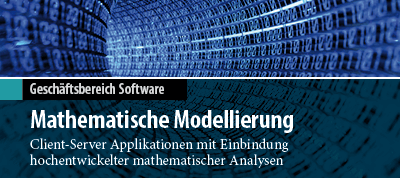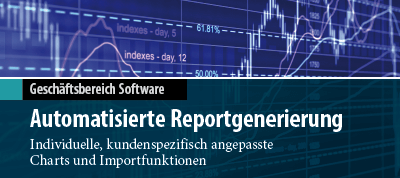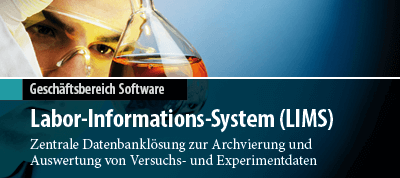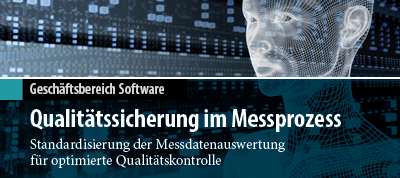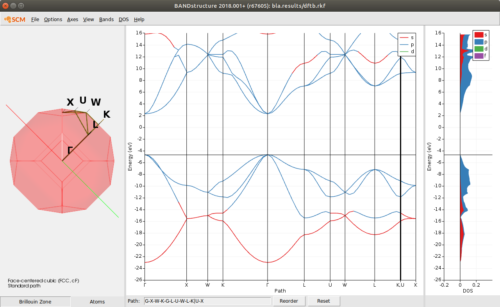Versionshistorie BAND: 2018 - 2013
Im Folgenden sehen Sie einen Überblick über die neuen Schlüsselfunktionen der jeweiligen Version.
BAND 2018
Neu in BAND 2018
In BAND, effective masses can now be calculated for any k-point. Through AMS, many useful properties are now available in BAND.
Highlights in BAND 2018
- Elastic tensor + moduli (bulk, shear, Young's); geometry optimization under pressure
- Linear Transit and PES scans: multiple degrees of freedom, any periodicity
- Molecular Dynamics
Quantum ESPRESSO has been updated to version 6.3, including preliminary support for CPMD. The binaries include phonons and electronic-phonon coupling (EPW), to be run from the command line.
Complete list of new functionalities in the BAND 2018 release
- Elastic tensor and related properties (e.g. Bulk modulus) (via AMS)
- Molecular dynamics (via AMS)
- Linear transit and PES scan (via AMS)
- Geometry optimization under pressure (via AMS)
- It's now possible to specify units in the input file
- Effective mass for arbitrary k-points
- Multi-Secant method for SCF convergence
AMS: a new driver program
In the 2018 release of the ADF Modeling Suite a new driver program called AMS is introduced. It is recommended to first read the General section of the AMS Manual.
If you use BAND exclusively via the Graphical User Interface (GUI), this change should not create any issues. If, on the other hand, you create input files by hand (or you use BAND via PLAMS), then you should be aware that shell scripts for BAND-2017 and previous versions are not compatible with BAND-2018 and have to be adjusted to the new setup.
The example below shows how a shell script for BAND-2017 is converted to BAND-2018.
BAND-2017 shell script (obsolete)
#!/bin/sh # This is a shell script for BAND-2017 which will not work for BAND-2018 $ADFBIN/band <<eor Units Length Angstrom End Atoms H 0.0 0.0 0.0 H 0.9 0.0 0.0 End GeoOpt Converge grad=1e-4 End BasisDefaults BasisType DZP End XC GGA PBE End eor
BAND-2018 shell script
#!/bin/sh # This is a shell script for BAND-2018 # The executable '$ADFBIN/band' is no longer present. # You should use '$ADFBIN/ams' instead. $ADFBIN/ams <<eor # Input options for the AMS driver: System Atoms H 0.0 0.0 0.0 H 0.9 0.0 0.0 End End Task GeometryOptimization GeometryOptimization Convergence gradients=1e-4 End # The input options for Band, which are described in this manual, # should be specified in the 'Engine Band' block: Engine Band Basis Type DZP End XC GGA PBE End EndEngine eor
Renaming/restructuring of input keys
The input syntax of several option has changed from the 2017 to the 2018 version of BAND. This is an incomplete list of key/blocks for which the input syntax has changed:
| BAND-2017 key | BAND-2018 key / comments |
|---|---|
| Accuracy | Option removed (use NumericalQuality instead) |
| AIMCriticalPoints | Added 'Enabled' sub-key to AIMCriticalPoints |
| ATensor | Added 'Enabled' sub-key to ATensor |
| AtomProps | Feature moved to AMS |
| Atoms | 'Atoms' is now part of AMS |
| BasisDefaults | Basis |
| BZStruct | BandStructure |
| Charge | 'Charge' is now part of AMS |
| Constraints | Constraints is now part of AMS |
| coordinates | This is now part of AMS |
| Define | None (option removed) |
| EffectiveMass | Added 'Enabled' sub-key and removed UniqueKPoints to EffectiveMass |
| EFG | Added 'Enabled' sub-key to EFG |
| ESR | Added 'Enabled' sub-key to ESR |
| FractionalCoords | This is now part of AMS |
| GeoOpt | GeometryOptimization (now part of AMS) |
| GridBasedAIM | Added 'Enabled' sub-key to GridBasedAIM |
| KSpace | Several sub-keys of the KSpace block changed |
| Lattice | Lattice is now part of AMS |
| NMR | Added 'Enabled' sub-key to NMR |
| OldResponse | Added 'Enabled' sub-key to OldResponse |
| PhononConfig | NumericalPhonons (now part of AMS) |
| Relativistic | Relativity |
| RunType | Task (now part of AMS) |
| Symmetry | UseSymmetry and SubSymmetry |
| Units | See units in the input file |
BAND 2017
Neu in BAND 2017
In comparison to BAND 2016, the BAND 2017 release offers the following new functionality:
- NEGF
- Transport through a molecular device[68]. See Electronic Transport (NEGF).
- Response for 2D (for NEWRESPONSE)
- Dielectric function for thin films.
- Response for 1D and 3D (for NEWRESPONSE)
- Enhanced performance for non-symmetric systems.
- Improved stability for systems with many bands.
- Restart from a smaller basis set
- Restart a difficult to converge TZP calculation from a SZ one.
- Restart from the density matrix, useful for NEGF.
- OEP for meta-GGA
- Option for the purists.
- Basis sets
- 1s frozen core basis sets added for the elements: Al, Si, P, S, Cl, and Ar
- Band structure:
- Fat-Bands for band structure analysis
- Labels for high-symmetry k-points
- New BandStructure visualization module
- Phonons
- Implemented isotopic shift (Atomic masses)
- Adjusted automatic K-space integration: significant speeds-up for phonons calculations with large supercells
- Two-sided numerical differentiation improves the precision of phonon calculations
- Default settings changed
- Band Structure and DOS no longer computed by default
- element 113 is named Nihonium (Nh) instead of Ununtrium (Uut),
- element 115 is named Moscovium (Mc) instead of Ununpentium (Uup),
- element 117 is named Tennessine (Ts) instead of Ununseptium (Uus), and
- element 118 is named Oganesson (Og) instead of Ununoctium (Uuo), following IUPAC
Apart from this new functionality and performance improvements, certain bugs have been fixed.
BAND 2016
Neu in BAND 2016
- Model Hamiltonians
- interface to LibXC: a library of exchange and correlation functionals
Thanks to the new interface to the LibXC library, many new XC functionals are available in Band, including: MVS and N12 (see http://www.tddft.org/programs/Libxc for the complete list). - Short Range-Separated Hybrids for periodic systems
Short range-separated hybrid functionals are useful for band gap predictions and provide good description of the ground-state properties of a wide range of materials. Thanks to a new Hartree-Fock RI scheme, short range-separated hybrid functionals are available in Band for 0D, 1D, 2D and 3D periodic systems (only for single point calculation. Not compatible with spin-orbit coupling). Available functionals include HSE03, HSE06, HJS-B97X, HJS-PBE and HJS-PBESOL. For the HSE functionals it's also possible to tune the switching parameter omega. - Hybrids for non-periodic systems
All hybrids functionals available in the LibXC library can be used in molecular (0D) Band calculations (only for single point calculations. Not compatible with spin-orbit coupling). - COSMO solvation model: various improvements
Changed the default COSMO surface from Esurf to Delley. The new defaults lead to more reliable geometry optimizations when using the COSMO solvation model. Furthermore, a bug affecting the numerical stability of the COSMO procedure has been fixed. - Tweaking Occupation numbers:
- User-defined Spinpolarization
This option allows for a user-defined excess of a particular electron spin. - Defining Electron Holes
This option enforces the depopulation of an occupied band. The energy difference with respect to the ground state is an approximation to the electron excitation energy.
- User-defined Spinpolarization
- interface to LibXC: a library of exchange and correlation functionals
- TDDFT
- New parameter-free Polarization Kernel
New parameter-free Polarization Kernel for accurate description of optical absorption spectra of insulators, semiconductors, and metals (only bulk systems) by A. Berger (http://dx.doi.org/10.1103/PhysRevLett.115.137402).
- New parameter-free Polarization Kernel
- Analysis
- Periodic Energy Decomposition Analysis (PEDA)
This analysis methods allows for the decomposition of the interaction energy between fragments of a system into the well-defined energy terms for the Pauli repulsion, the electrostatic interaction and the orbital relaxation. These can be used to describe the chemical nature of the interaction for this particular combination of fragments. (M. Raupach and R. Tonnerhttp://dx.doi.org/10.1063/1.4919943). - PEDA Combined with Natural Orbitals for Chemical Valency (PEDA-NOCV)
This analysis method allows for the decomposition of the orbital relaxation term into several parts based on NOCV pairs. Additional visualization of the respective NOCV deformation densities offers the association with e.g. sigma- or pi-like bond formation (M. Raupach, T. Ziegler and R. Tonner).
- Periodic Energy Decomposition Analysis (PEDA)
- Structure and Reactivity
- Analytical Lattice Gradients
(expert option, feedback is welcome) Initial implementation for analytical lattice gradients to speed up lattice optimizations. For 1D periodic systems (such as nanotubes) a speedup of 2 is achievable. For highly symmetric bulk systems, the lattice optimization is typically slower, compared to using numerical lattice gradients (symmetry is not yet employed).
- Analytical Lattice Gradients
Scripting
- ASE interfaced with the ADF modeling suite programs
The Atomic Simulation Environment (ASE) tool collection suite was designed as a flexible, easy-to-use, and customizable approach for the manipulation of quantum chemical models as well as for setting up and running the calculations required and for the analysis of the final results. D. Coupry and T. Soini at SCM have built ASE calculators for the main codes in the ADF Modeling Suite, thus opening up several of the methods in ASE. - PLAMS: Python Library for Automating Molecular Simulation
The PLAMS Python library, developed at SCM by Michał Handzlik, aims at facilitating scripting and work-flow automation in molecular modeling. PLAMS takes care of input preparation, job execution, file management and output processing and comes with interfaces to ADF, BAND and DFTB. SCM is making PLAMS available to the community as open-source (LGPL), contact SCM for details. Together with the related pyADF project led by Prof. Christoph Jacob, PLAMS is one of the components in the ongoing open-source project Computational Chemistry made Easy , led by Prof. Lucas Visscher, in which SCM also participates (contact Prof. Visscher or SCM for more information). - FlexMD (Flexible multi-scale Molecular Dynamics simulation): new features
FlexMD is a python library developed by Rosa Bulo's group at Utrecht University for molecular dynamics, specialized in multi-scale simulations. It is currently an expert option that requires scripting experience. The 2016 release includes a tabulated PBE-based force field for water suitable for QM/MM simulations. The center of the QM region can now also be defined more flexibly, e.g. as the position of a hydronium or hydroxide ion, important for simulating proton transfer processes. - adfprep and adfreport : New features for the command line tools adfprep (job preparation) and adfreport (results extraction):
- Support for ADF, BAND, ReaxFF, DFTB, UFF, Mopac
- Fragment support
- Geometry changes, modify atom types, add groups
- Support for SDF files
BAND 2014
Neu in BAND 2014
- Changed defaults
- NUMERICALQUALITY concept. Now the precision of all key algorithms can be controlled with a simple Quality key, and the overall NUMERICALQUALITY sets the default for these. Similar in spirit to the old Accuracy keyword. Does not affect the basis set or model Hamiltonian.
- Fit method: ZlmFit (was STO fit). This has two advantages, namely that the performance scales much better with system size, and secondly that the accuracy can be systematically improved (or worsened). Although the STO fit was quite accurate, especially when using the QZ4P fit, this was not so for the Lanthanide and Actinide series, for which the standard STO fit sets lacked functions with extra high l to describe partially filled f shells. Finally the screening function is no longer needed to calculate the Coulomb potential. This is now obtained via a proper summation of the multipole terms. The screening was inefficient with stretched unit cells, and not so accurate when having a dipole in the z-direction in a slab or linear chain calculation.
- Grid: Becke grid (was Voronoi grid). The advantage is that the error of the Becke grid is more smooth as a function of geometry, thus stabilizing geometry optimizations.
- KSpace: use a regular grid with a possibly different mesh per direction. The underlying algorithm is unchanged, namely the quadratic analytical tetrahedron method. The default sampling now depends on the size of the lattice vectors: the bigger the real space lattice, the smaller the number of k-points.
- Confinement: at lower levels of NUMERICALQUALITY use smooth confinement, for better localization of the basis functions. In principle this changes a bit (the radial behavior of) the basis set.
- Direct: no more reading/writing of basis functions from/to the disk. Does not affect the results.
- For NMR, and Response calculations the old defaults are used. The same is true for systems with cylinder symmetry.
- Non-collinear spin
When doing a spin-orbit coupled relativistic calculation, it is now possible to use a non-collinear magnetization density. Normally the z-component of this vector is used as the polarization density in the non-relativistic XC functional. In the non-collinear model the size of the vector is used as spin-polarization. - LISTi and LISTb SCF convergence accelerators
For systems that are difficult to converge there is now the alternative to use the LISTi method. Typically this reduces the number of cycles needed to reach convergence, however it is quite a bit more expensive per SCF step, because an extra density fitting step is needed. - Significantly smaller RUNKF files
The number of matrices stored on the result file has been reduced to what is really needed for restarts. For k-points that are real only the real part of the matrices is stored. - Local quality
It was already possible to specify basis sets per atom. Now also the grid for numerical integration and the density fitting can be configured to be better for some atoms and worse for others. In the region of interest you can use a good basis set and an accurate numerical grid and density fit, while using a simple basis set and reduced accuracy for the rest of the system. - DZP basis set
Like ADF, band now also has a DZP basis set. It is defined not for all elements, and it defaults to the TZP basis if it is not available for an element. The DZP basis set gives much better geometries than the DZ basis. It is however not advised for adsorption of organic molecules on transition metal slabs, because the TM atoms will be described with a TZP basis and the molecule with a DZP basis. This imbalance may lead to a artificial deformation of the slab.
BAND 2013
Neu in BAND 2013
- effective mass (electron/hole transport)
- GLLB-SC model potential with derivative discontinuity for band gap prediction
- Fermi surface
- optional Becke grid for numerical integration
- finite nucleus option
- density at nucleus
- various performance improvement








